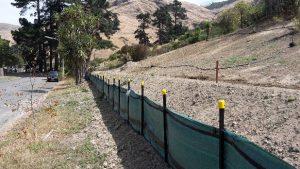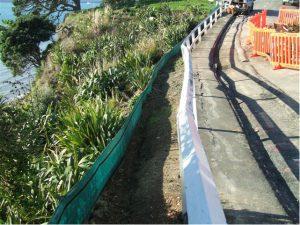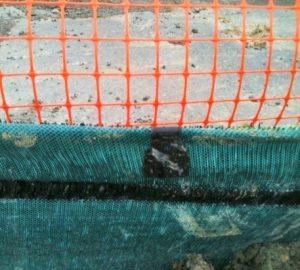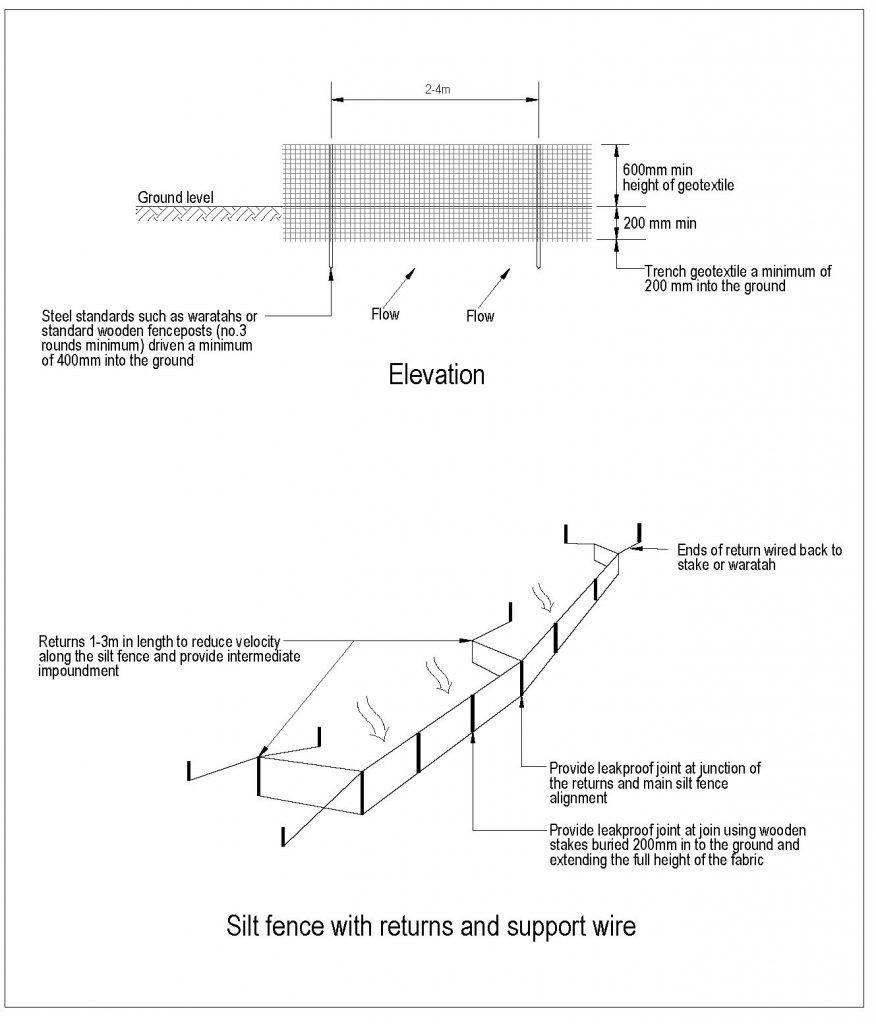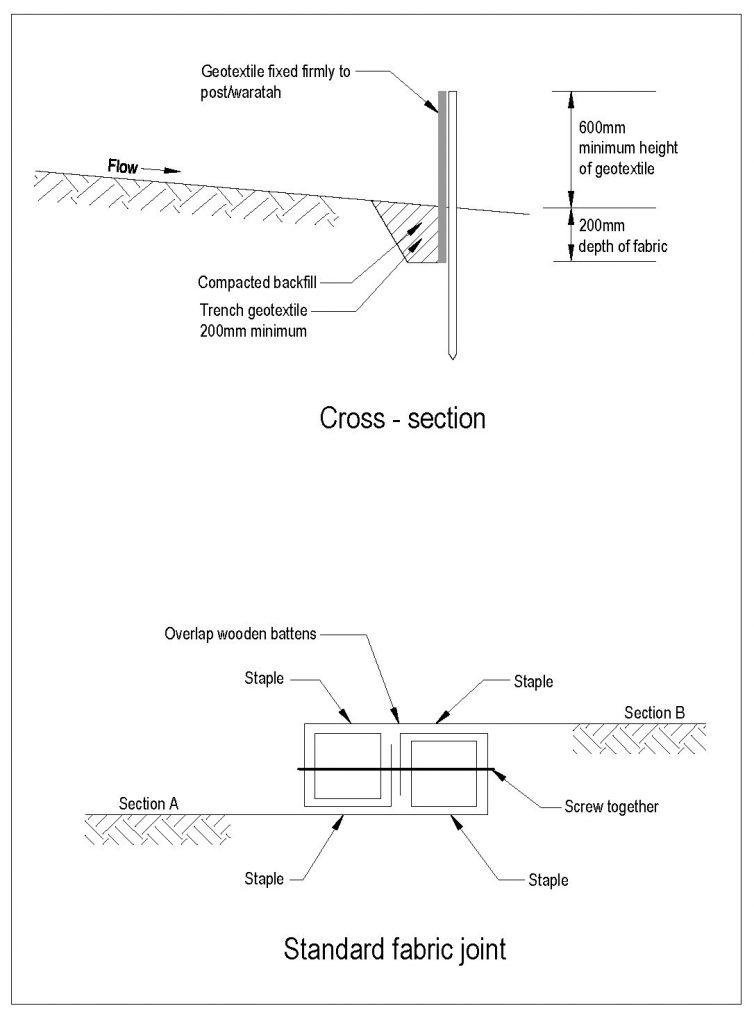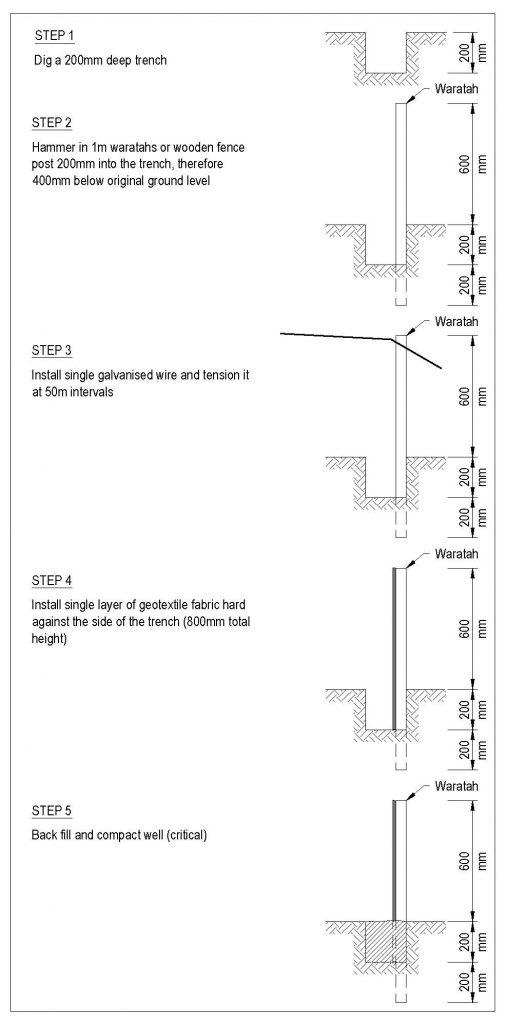Sediment Control
Silt fences
What, why, when, and issues to look out for
What
A silt fence is a temporary barrier of woven geotextile fabric that captures mainly coarse sediments carried in sheet flow.
Silt fences temporarily impound sediment-laden runoff, slowing down the flow rate and allowing sediment to settle out of the water. They cannot treat concentrated flows of sediment-laden water – for these situations use sediment retention ponds and decanting earth bunds.
Why
Silt fences detain runoff flows so that transported sediment can be deposited by settlement. They are not used to filter sediment out of runoff.
When
Silt fences are mainly used in the following situations:
- To control sediment by intercepting sheet flow
- If a site is low gradient, or is confined with a small contributing catchment, such as short batter fills and around watercourses
- To mark out the boundary limits of disturbance on earthworks sites, such as riparian areas or bush reserves
- If installing an earth or topsoil bund would destroy sensitive areas, such as bush and wetlands.
Issues to look out for
Silt fences have the following limitations:
- Silt fences do not capture many soil particles finer than 0.02 mm in diameter (for example fine silts and clays, including loess). This is because of the short time that water is detained and the relatively large pore size of most of the fabrics.
- The pores in the silt fence fabric become clogged relatively quickly with fine textured sediments, so the fabric becomes impermeable. You might need to add additional reinforcing like a super silt fence (chain link fence).
- You must not install silt fences across watercourses, in areas of concentrated flows or try to use them as check dams in channels. Only use silt fences for sheet flows.
- As installation of silt fences requires excavation and disturbance of soil, carefully consider whether this is the right tool for the situation. Close to waterway margins the excavation required to install the silt fence can potentially affect water quality, so consider other tools, such as compost bunds, that may have less risk.
- Use silt fences along with other tools from this toolbox as part of a treatment train, mix and match approach.
Design essentials
The following points are design essentials:
- Make sure that the silt fence height is 600 mm above ground level.
- Apply the maximum slope lengths and spacing of returns and angles given in Silt fence design criteria table.
- If there is a change in slope, no section of the fence should exceed a grade of 5% for a distance of more than 15 m.
- Put supporting posts/waratahs for silt fences 2–4 m apart, and use tensioned wire (2.5 mm HT) for support along the top.
- If you are using a strong woven fabric with a wire support, the distance between posts can be up to 4 m. Double the silt fence fabric over and fasten it to the wire with silt fence clips, 500 mm apart.
- Embed supporting posts/waratahs at least 400 mm into the ground.
- Always install silt fences along the contour (at a break in slope). If this is not possible, or if there are long sections of silt fence, install short silt fence returns projecting upslope from the silt fence to minimise the concentration of flows. Silt fence returns should be at least 2 m long, and can incorporate a tie back. You usually make them by continuing the silt fence around the return and doubling back, to eliminate joins.
- Join lengths of silt fence by doubling over fabric ends around a waratah or by stapling the fabric ends to a batten and butting the two battens together.
- Install silt fence returns at either end of the fence, projecting upslope high enough to prevent outflanking.
- If the catchment is over 0.3 ha, you need to consider whether a silt fence works well enough for that particular site. A different control measure may be better, eg a super silt fence.
-
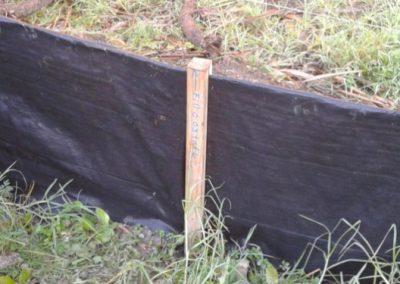
Battens joining silt fence fabric ends (Source: SouthernSkies).
-
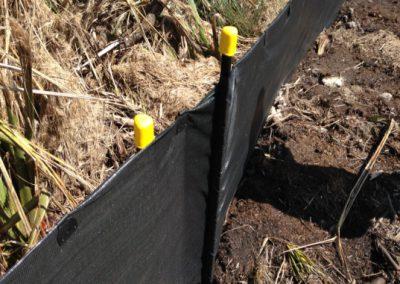
Doubling the fabric over at the end around the waratah (Source: SouthernSkies).
-
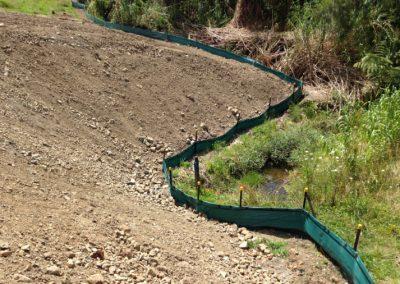
Contours create the same effect as returns in this case; in other situations ensure returns are installed (Source: SouthernSkies).
| Slope steepness | Slope length (m) (maximum) | Spacing of returns (m) | Silt fence length (m) (maximum) |
|---|---|---|---|
| Flatter than 2% | Unlimited | N/A | Unlimited |
| 2–10% | 40 | 60 | 300 |
| 10–20% | 30 | 50 | 230 |
| 20–33% | 20 | 40 | 150 |
| 33–50% | 15 | 30 | 75 |
| >50% | 6 | 20 | 40 |
- If water might pond regularly behind the silt fence, give the fence extra support with tie backs from the silt fence to a central stable point on the upward side. You can also string wire between the support stakes and connect the filter fabric to this wire.
- As a minimum, the silt fence cloth must meet the following criteria for geotextile fabric:
- Grab tensile strength: >440N (ASTM D4632)
- Tensile modulus: 0.140 pa (minimum)
- Apparent opening Size: 0.1–0.5 mm (ASTM D4751).
Construction and operation
- Use silt fence material appropriate to the site conditions and according to the manufacturer’s specifications.
- Always install silt fences along the contour.
- Excavate a trench at least 100 mm wide and 200 mm deep along the proposed line of the silt fence.
- Use waratahs at least 1.5 m long.
- Install the support waratahs on the downslope edge of the trench and silt fence fabric on the upslope side of the support waratahs to the full depth of the trench. Then backfill the trench with compacted soil.
- Install the waratahs so that they are as flat as possible against the silt fence. If the waratah edge is against the silt fence, it will rub and eventually rip against the waratah.
- Use the right silt fence clips to secure the fence material to the top wire. Don’t use wire ties and staples because these rip the material if the weight of the impounded water pushes against it.
- Reinforce the top of the silt fence fabric with a support made of high tensile 2.5 mm diameter galvanised wire. Tension the wire using permanent wire strainers attached to angled waratahs at the end of the silt fence.
- Where the ends of silt fence fabric come together, make sure that they are overlapped, folded and stapled or screwed to stop sediment bypass.
Maintenance and decommissioning
When maintaining silt fences
- Inspect them at least once a week and after each rainfall.
- Check for damage including rips, tears, bulges in the fabric, broken support wires, loose waratahs, overtopping, outflanking, undercutting, and leaking joins in the fabric. Repair any problems as soon as you see them.
- When the geotextile material becomes clogged with sediments, the ponding will last for longer. Carefully clean the silt fence geotextile with a light broom or brush to maintain performance.
- Remove sediment when the fence bulges or when sediment accumulation reaches 20% of the fabric height. But also remove sediment deposits as necessary before either of these situations happens, to make sure that there will be adequate sediment storage and to reduce pressure on the fence.
- Dispose of sediment to a secure area to make sure that it doesn’t discharge to the receiving environment.
When decommissioning silt fences
- Stabilise the catchment area
- Remove the silt fence and accumulated sediment
- Dispose of the accumulated sediment correctly
- Backfill the trench, then re-grade and stabilise the disturbed area.
